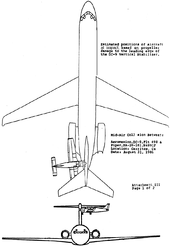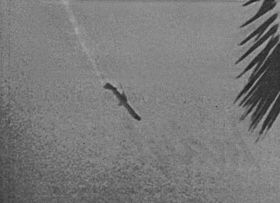Aeroméxico Flight 498
| Aeroméxico Flight 498 | |
|---|---|
|
Flight 498 crashes after the collision. |
|
| Accident summary | |
| Accident type | Airplane collision in the air |
| place | Cerritos in California ( USA ) |
| date | August 31, 1986 |
| Fatalities | 82 (including 15 on the ground) |
| Injured | 8 (floor) |
| 1. Aircraft | |
| Aircraft type | Douglas DC- 9-32 |
| operator | Aeroméxico |
| Mark | XA-JED |
| Departure airport |
Mexico City Mexico Airport |
| Destination airport |
Los Angeles International Airport California (USA) |
| Passengers | 58 |
| crew | 6th |
| Survivors | 0 |
| 2. Aircraft | |
| Aircraft type | Piper PA 28-181 Archer II |
| operator | Privately owned |
| Mark | N4891F |
| Departure airport | Zamperini Field Torrance , California (USA) |
| Destination airport | Airfield in Big Bear City , California |
| Passengers | 2 |
| crew | 1 |
| Survivors | 0 |
| Lists of aviation accidents | |

Aeroméxico flight 498 was the flight number of a scheduled flight of Aeroméxico from Mexico City to Los Angeles , in which on August 31, 1986 the Douglas DC-9 machine used collided with a small aircraft in the air . All 67 people were killed in the resulting crash, including 10 children. In addition, 15 people died on the ground and eight others were injured. The cause of the accident were errors made by the pilot of the small aircraft and air traffic control .
Aircraft
The aircraft, a Douglas DC-9 -32, with the aviation identification XA-JED and the production number 47356, made its maiden flight on February 21, 1969 and was delivered to the American airline Delta Air Lines on April 18, 1969 . Since November 30, 1979 it was part of the fleet of the Mexican airline Aeroméxico. The machine was equipped with Pratt & Whitney JT8D engines .
The Piper PA-28 with the registration number N4891F was privately owned.
The accident
the accident
The DC-9-32 had taken off from Mexico City Airport and was en route to Los Angeles International Airport , California . The flight plan provided for stopovers in Guadalajara , Loreto ( Baja California Sur ) and Tijuana . There were 58 passengers and six crew members on board.
On board the Piper were a pilot and two passengers. The small plane was about 11:40 ( PST ) in Torrance ( Los Angeles County started) and was on the flight to Big Bear City . It flew according to visual flight rules (VFR). At about 11:46 a.m. (PST), Flight 498 began its descent to land in Los Angeles. The passenger plane was flying according to instrument flight rules (IFR). The visibility was over 30 kilometers, the sky was cloudless.
At 11:52 a.m. (PST), the Piper collided with the left horizontal stabilizer of the DC-9 at a height of approximately 1980 meters above the village of Cerritos . As a result of the impact, the upper section of the Piper's cockpit was sheared off and the pilot and both passengers were beheaded. The Piper fell on the grounds of a playground of the Cerritos Elementary School , on which at that time (on a Sunday) there were no people.
The badly damaged DC-9 then rolled onto her back . She crashed in a very top-heavy flight position about 32 kilometers east-southeast of the airport in the residential areas of Holmes Avenue and Reva Circle in the city of Cerritos. The passenger plane crashed into a ball of fire on impact. The crash and the ignited fire destroyed five houses and damaged seven more.
When the responsible air traffic controller could no longer find Flight 498 on the radar screen , he radioed American Airlines 333, which was also on its way to Los Angeles. The cockpit crew of AA333 replied that they could see a column of smoke.
Determination of causes
The National Transportation Safety Board (NTSB) was commissioned to investigate the accident .
The investigation revealed that the Piper N4891F had gone off course and illegally flown into the local traffic operating zone (TCA) of Los Angeles Airport. The pilot had made no radio contact with air traffic control. The air traffic controller himself had been distracted by another aircraft, a Grumman Tiger . This had also flown into the control zone without clearance and asked for help with navigation.
In addition, the Piper was not equipped with a mode C transponder for the secondary radar, which would have indicated the flight altitude to the controller in the tower. The airport again did not have a warning system that could generate such messages. Nevertheless, the Piper's echo was visible on the radar screen through an on-board ready-to-use interrogator without height coding, as the recording tape of the control center later revealed. The air traffic controller had not noticed the target, possibly because the image resolution of the radar was reduced by a temperature reversal in the atmosphere .
It must be assumed that both crews had not seen the other aircraft, although they were in sight. None of the planes tried to evade prior to the collision. As it turned out in later tests, the light aircraft in particular would have had the opportunity to recognize the passenger plane in good time. The autopsy of the 53-year-old private pilot of the Piper revealed a massive blockage of the coronary vessels . For a while it was speculated that the pilot might have suffered a heart attack prior to the collision and thereby render the aircraft driverless. Later forensic investigations disproved this thesis.
The unauthorized flight of the Piper into the TCA was found to be the main cause of the accident. Since the private pilot was considered level-headed and professional and was familiar with the regulations about the TCA, it is believed that he was likely to misidentify a control point on the ground while navigating.
Consequences of the accident
As a result of the accident, it was made mandatory that all airports must be equipped with collision warning devices ( NMAC ) for the control zones . In addition, the Federal Aviation Administration stipulated that all commercial aircraft must be equipped with TCAS and small aircraft with Mode-C transponders.
Commemoration
On March 11, 2006, a memorial was inaugurated in Cerritos with a sculpture in memory of the accident victims, which is part of a sculpture garden. The artwork was designed by the sculptor Kathleen Caricof. It consists of two black granite blocks of different sizes on a base , on which the names of all victims are embedded. On each cube there are two free-form structures made of gray-white marble, reminiscent of wings . The bench set up in front of the sculpture is a third element of the work of art and is intended to invite visitors to take a seat and to commemorate the victims of the disaster.
Trivia
The crash was covered in an episode of the series Mayday - Cockpit Alarm , which first aired on April 24, 2007 under the title Out of Sight on US television.
In addition, the accident served as a template for the aircraft disaster, which will be the theme of the entire second season of Breaking Bad . The main character of the series bears the same name as the air traffic controller on duty, whom the court gave the responsibility for the accident: Walter White.
See also
- Pacific Southwest Airlines Flight 182 : a similar accident near San Diego .
literature
- David Gero: Aviation disasters: accidents with passenger aircraft since 1950 ; Motorbuch-Verlag, Stuttgart 1994; ISBN 3-613-01580-3 .
- detailed article in Aero, issue 1/2009, pp. 86–88
Web links
- NTSB accident report of March 7, 1988
- Accident report DC-9-32 XA-JED , Aviation Safety Network (English), accessed on November 27, 2017.
- Collision Over Cerritos. Aircraft Owners and Pilots Association , accessed August 18, 2009 .
- California Jet Crash Led to Sweeping Changes. In: The New York Times . Retrieved August 18, 2009 .
- The History of the City of Cerritos, Chapter 8 (Aeroméxico Flight 498)
- Landmark Accidents: Collision Over Cerritos , AOPA report on influential aviation accidents
Individual evidence
- ^ The New York Times: Collision Victims on DC-9 , Sep. 2, 1986, p. 7, column 5 (National Desk)
- ↑ NTSB : Accident report 87/07 ( Memento from December 2, 2007 in the Internet Archive ) (pdf; 5.4 MB)
- ↑ jetphotos.net: McDonnell Douglas DC-9-32-XA-JED
- ^ Ed Magnuson: Collision in the "Birdcage" ; TIME dated June 24, 2001.
- ^ A b c David Gero: Aviation disasters: Accidents with passenger aircraft since 1950 ; Motorbuch-Verlag, Stuttgart 1994; ISBN 3-613-01580-3 ; Pp. 190-192
- ↑ Cerritos Municipality: The Story of Cerritos: Chapter 8 1976–1986 Groth, Development and an Unnatural Disaster
- ^ Daily Herald (Chicago): Aircraft Collision Over Los Angeles Suburb , Sept. 2, 1986, p. 6
- ^ Larry Gerber, AP, 1986 Cerritos crash changed the way we fly, Doylestown, Sep. 1, 1996, pp. A-13
- ↑ Cerritod City Council: Sculpture Garden dedication press release ; March 31, 2006
- ↑ Samantha Gonzaga: Garden dedicated to air crash victims . In: Whittier Daily News, March 11, 2006
- ↑ National Sculptors' Guild: Curriculum Vitae Kathleen Caricofs ( Memento from August 22, 2006 in the Internet Archive ) (pdf)
- ↑ Cerritos City Council: “Cerritos Air Disaster Memorial”
- ^ Jury Fixes Blame for Crash That Killed 82 New York Times, April 15, 1989.
Coordinates: 33 ° 52 '5 " N , 118 ° 2' 44" W.



